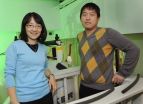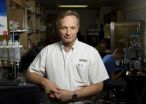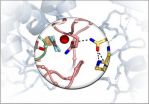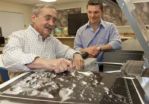(Press-News.org) WASHINGTON, D.C., (Oct. 21, 2010) -- Over the past decade, Christine Mahoney and a team of scientists at the National Institute of Standards and Technology (NIST) in Maryland have been working to stop the threat of terrorist-based attacks in the form of explosives or explosive-based devices, by providing a sound measurement and standard infrastructure.
"Our program encompasses many different aspects of explosives research, from development of measurement standards for trace explosives detection at airports, to the development and application of new metrology for the direct characterization and identification of these explosives," says Mahoney, who is making a presentation today at the AVS 57th International Symposium & Exhibition, which takes place this week at the Albuquerque Convention Center in New Mexico.
One measurement technique, Time-of-Flight Secondary Ion Mass Spectrometry (ToF-SIMS) is proving to be critical for identifying and differentiating the various components of explosives. ToF-SIMS is a mass spectrometric-based imaging technique that is able to detect components such as plasticizers, binders, oils, and the explosives themselves. It can potentially be used to differentiate between explosive manufacturers and to reveal an explosive material's country of origin.
Unlike traditional analytical techniques such as gas and liquid chromatography, which can provide a partial analysis of extracted samples, ToF-SIMS and other mass spectrometric imaging techniques allow for the simultaneous and direct characterization of all the components in explosives like C4, including the explosive active components, additives, binders, and contaminants. ToF-SIMS provides rapid identification of both organic and inorganic constituents and their characteristic isotopic abundances with excellent sensitivity. Most importantly, it is well-suited for direct analysis of small explosive particulates collected directly in the field and sent back to the lab.
According to Mahoney, the laboratory technique is sensitive enough to detect bits of explosive material scattered in a fingerprint, making it a potentially powerful forensic tool. "It's a more thorough way of looking at the material," says Mahoney. "We look at everything all at once."
Using ToF-SIMS in combination with other techniques that visualize the crystal structure of the samples, Mahoney identified and differentiated between commercial C4, military C4 from the United States, and C4 from the U.K.
The ultimate goal of the project, though, is not to develop ToF-SIMS as a portable technology to use in the field. Rather, Mahoney is creating a library of precise, standardized reference samples that could be used to test, calibrate, and optimize new technologies for detecting explosives in the field.
"We can really nail down the differences in the chemistries between different kinds of explosives," said Mahoney.
###
The talk, "Characterization of Composition C4 Explosives using Time-of-Flight Secondary Ion Mass Sepctrometry (ToF-SIMS) and X-Ray Photoelectron Spectroscopy (XPS)" is at 10:40 a.m. on Thursday, October 21, 2010. Abstract: http://www.avssymposium.org/Open/SearchPapers.aspx?PaperNumber=AS2-ThM-9
MORE INFORMATION FOR JOURNALISTS
The AVS 57th International Symposium and Exhibition is being held October 17-22, 2010, at the Albuquerque Convention Center, in Albuquerque, New Mexico. The meeting includes more than 1,200 talks and posters presented in more than 130 technical sessions. All meeting information, including directions to the Convention Center, can be found at:
http://www2.avs.org/symposium/
REGISTRATION -- Staff reporters and professional freelance journalists working on assignment are invited to attend the conference free of charge. Journalist registration instructions can be found at:
http://www2.avs.org/symposium/AVS57/pdfs/pressinvite.pdf
PRESS ROOM
The AVS press room will be located in East Lobby of the Albuquerque Convention Center. Press room hours are Monday-Thursday, 8:00 a.m. to 5:00 p.m. The phone number there is 408-205-0595. Press Kits containing company product announcements and other news will be available on CD-ROM in the press room. Also access the online press room at: http://www2.avs.org/symposium/AVS57/pages/press57.html
USEFUL LINKS
Complete Program: http://www2.avs.org/symposium/AVS57/pages/tech_program.html
Searchable abstracts: http://www.avssymposium.org/Open/SearchPapers.aspx
Topical Conferences: http://www2.avs.org/symposium/AVS57/pages/tech_topconf.html#EN
Meeting Home Page: http://www2.avs.org/symposium/
PLENARY SESSION
The plenary talk, "Carbon Nanotubes and Single Sheet Graphene," which will be at noon on Monday, October 18, 2010 in Ballroom B of the Albuquerque Convention Center. See: http://www2.avs.org/symposium/AVS57/pages/sessions_lecturer.html
SPECIAL TUTORIALS
AVS promotes communication, dissemination of knowledge, recommended practices, research, and education in a broad range of technologically relevant topics. One way that it does this is by offering special tutorials in areas such as:
- Graphene Tutorial (Sunday, October 17, 2010, 1:00-5:00 p.m.)
- Tutorial on Nanoparticle Characterization and Toxicity: Significant Challenges and Critical Needs (Sunday, October 17, 2010, 1:00-5:00 p.m.)
To access the complete descriptions of these special tutorials, see:
http://www2.avs.org/symposium/AVS57/pages/special_tutorials.html
ABOUT AVS
As a professional membership organization, AVS fosters networking within the materials, processing, and interfaces community at various local, national or international meetings and exhibits throughout the year. AVS publishes four journals, honors and recognizes members through its prestigious awards program, offers training and other technical resources, as well as career services.
END
Measuring three biomarkers in a single blood sample may improve physicians' ability to identify patients at high risk of developing chronic kidney disease (CKD), according to a study appearing in an upcoming issue of the Journal of the American Society of Nephrology.
"Our results identify biomarkers that can improve CKD risk prediction," comments Caroline S. Fox, MD, MPH of the National Heart, Lung, and Blood Institute's Framingham Heart Study, Framingham, Mass.
The study included more than 2,300 participants in the Framingham Offspring Study, a long-term follow-up ...
NASA's Lunar Reconnaissance Orbiter (LRO) and its sophisticated suite of instruments have determined that hydrogen, mercury and other volatile substances are present in permanently shaded soils on the Moon, according to a paper published today in Science.
The Lunar Crater Remote Observation and Sensing Satellite (LCROSS), which launched with LRO, was intentionally crashed onto the Moon's surface Oct. 9, 2009, while LRO instruments watched. About 90 seconds after LCROSS hit the Moon, LRO flew past the debris plume raised by the impact, while the Lyman Alpha Mapping Project ...
AMES, Iowa – The flu virus uses a shuttle mechanism to relay protons through a channel in a process necessary for the virus to infect a host cell, according to a research project led by Mei Hong of Iowa State University and the Ames Laboratory.
The findings are published in the Oct. 22 issue of the journal Science.
Hong, an Iowa State professor of chemistry and an associate of the U.S. Department of Energy's Ames Laboratory, said her research team used solid-state nuclear magnetic resonance (NMR) spectroscopy to determine the structure and workings of the proton channel ...
Beating the flu is already tough, but it has become even harder in recent years – the influenza A virus has mutated so that two antiviral drugs don't slow it down anymore.
Reporting their findings in the journal Science, researchers from Florida State and Brigham Young move closer to understanding why not, and how future treatments can defeat the nasty bug no matter how it changes.
The two drugs, amantadine and rimantadine, are no longer recommended by the CDC for use against flu.
They used to work by blocking a hole in the influenza A virus called the "M2 channel," ...
(Embargoed) Scientists at the University of North Carolina at Chapel Hill School of Medicine have reported the exact molecular structure and mechanisms of a major cell signaling pathway that serves a broad range of functions in humans.
Up to half of drugs approved by the US Food and Drug Administration directly or indirectly target G protein-coupled receptors. These receptors, which are proteins that live in the outer membranes of cells, take molecular signals from outside the cell and convert them into responses within – and those responses help control behaviors as ...
Research led by Klaus Stark and Christian Hengstenberg of the University of Regensburg identified a common variant of the cardiovascular heat shock protein gene, HSPB7, which was found to increase risk for dilated cardiomyopathy by almost 50%. Their paper appears on October 28 in the open-access journal PLoS Genetics.
Per year, about 6 in 100,000 individuals develop dilated cardiomyopathy (DCM), with a higher prevalence in men. This disease is characterized by an enlarged, weakened heart, subsequently affecting the pumping capacity and often leading to chronic heart failure. ...
CAMBRIDGE, Mass. -- Most marathon runners know they need to consume carbohydrates before and during a race, but many don't have a good fueling strategy. Now, one dedicated marathoner -- an MD/PhD student in the Harvard-MIT Division of Health Sciences and Technology -- has taken a more rigorous approach to calculating just how much carbohydrate a runner needs to fuel him or herself through 26.2 miles, and what pace that runner can reasonably expect to sustain.
The result is a new model, described in the Oct. 21 issue of the journal PLoS Computational Biology, which allows ...
VIDEO:
Peter Schultz and graduate student Brendan Hermalyn analyzed data from bits of the Moon’s surface kicked up by a NASA-engineered collision. They found unexpected complexity -- and traces of silver....
Click here for more information.
PROVIDENCE, R.I. [Brown University] — Scientists led by Brown University are offering the first detailed explanation of the crater formed when a NASA rocket slammed into the Moon last fall and information about the composition of the ...
STANFORD, Calif. — In a study to be published online Oct. 21 in PLoS Genetics, researchers at the Stanford University School of Medicine have implicated the lack of a protein important in hooking our skin cells together in the most common variety of skin cancer. Depletion of this protein, called Perp, could be an early indicator of skin cancer development, and could be useful for staging and establishing prognoses.
These findings' significance may extend beyond skin cancer, as Perp is found in the linings of many of our internal organs, where it plays the same role it ...
Injecting a protein that helps break down triglycerides may someday help treat an inherited form of high triglycerides, according to a new study in Arteriosclerosis, Thrombosis, and Vascular Biology, an American Heart Association journal.
Triglyceride is a type of fat in the blood. Elevated levels in the blood — hypertriglyceridemia — have been linked to coronary artery disease.
In the study, researchers tested a new compound in mice genetically altered to be deficient in a protein called apolipoprotein (apo)A-V, which causes them to have high blood levels of triglycerides. ...




